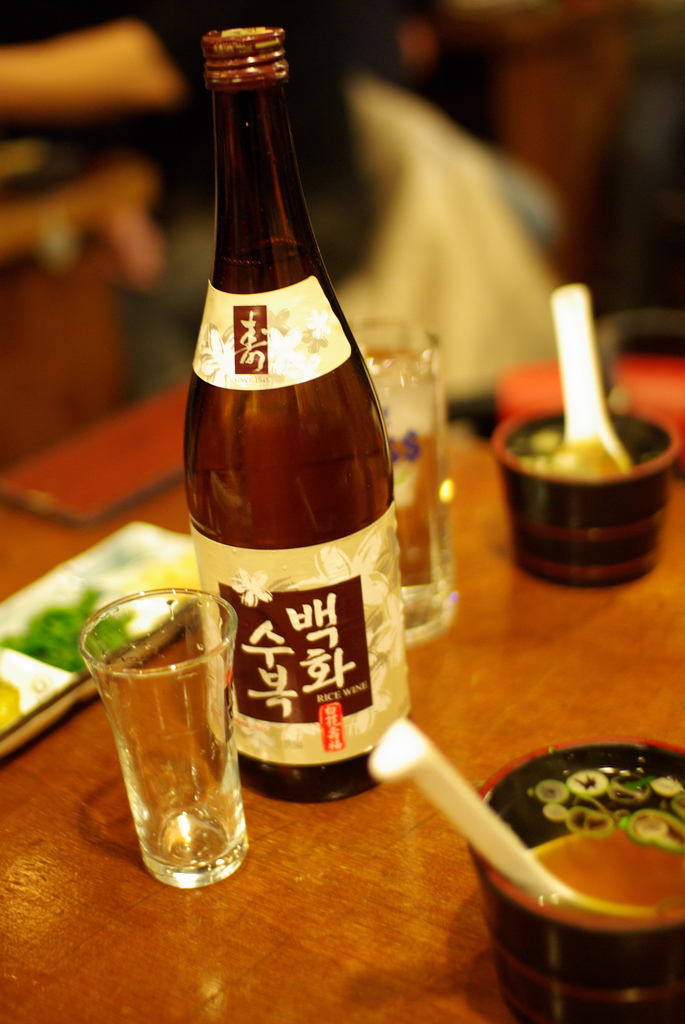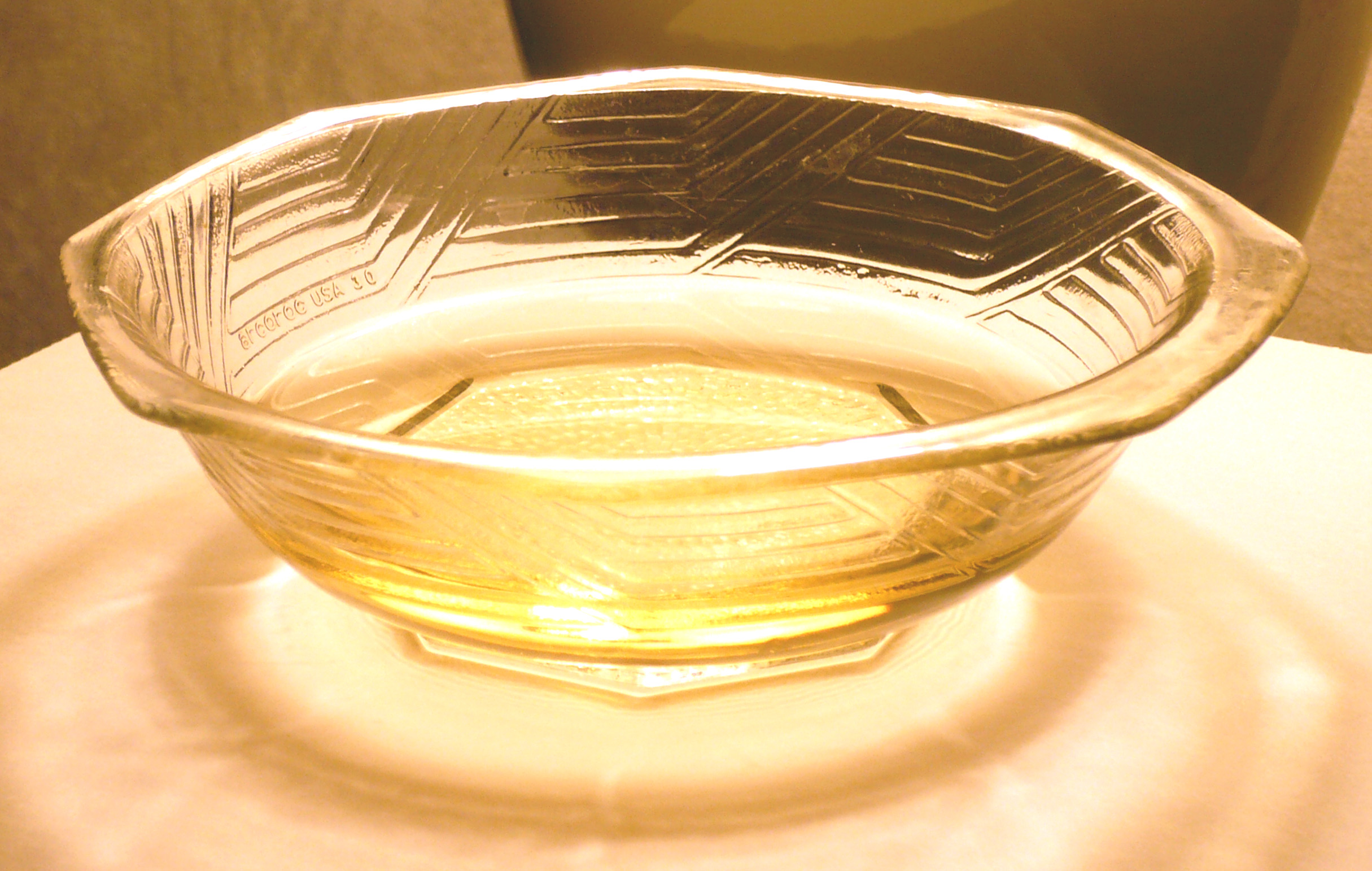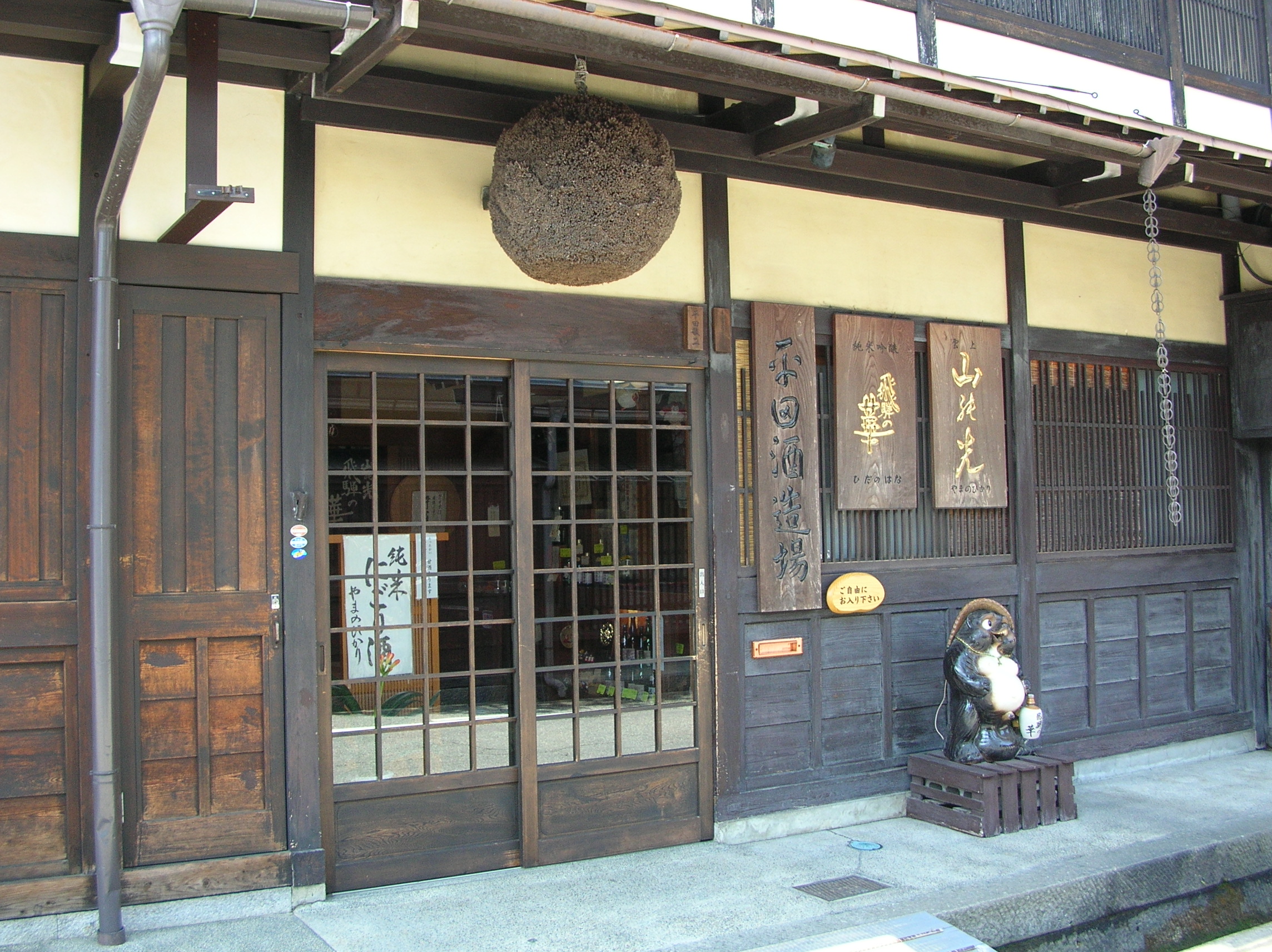|
Mijiu
Mijiu () is a Chinese rice wine made from glutinous rice. It is generally clear in appearance with balanced sweetness and acidity, similar to its Japanese counterpart sake and Korean counterpart cheongju. The alcohol content ranges between 15% and 20%. Rice wine was made around or before 1000 BC in ancient China, and then the practice spread to Japan and other East Asian countries. Since then, it has played an important role in Chinese life. In most Chinese supermarkets there are various kinds of rice wines. It is a traditional beverage to the Chinese and some of the families still follow the custom of making rice wine by themselves. The rice wine is made using glutinous rice, Chinese yeast and water. It is also served as an aperitif and is believed to be beneficial in improving metabolism and skin. Mijiu is usually drunk warm, like the Japanese sake and Korean cheongju, and is also used in cooking. The cooking mijiu available in Asian grocery stores are generally of a lower qu ... [...More Info...] [...Related Items...] OR: [Wikipedia] [Google] [Baidu] |
Huangjiu
''Huangjiu'' (), meaning yellow wine, is a Chinese alcoholic beverage, and is most popular in the Jiangnan area. ''Huangjiu'' is brewed by mixing boiled grains including rice, glutinous rice or millet with qū as starter culture, followed by saccharification and Fermentation in food processing, fermentation at around 13-18 °C for fortnights. Its alcohol content is typically 8%-20%. ''Huangjiu'' is usually pasteurized, aged, and filtered before its final bottling for sale to consumers. Pasteurization, Pasteurisation removes impurities as well as stabilising the aromatic flavour compounds. Maturation (wine), Maturation process can be complicated but important for the development of the layers of flavours and fragrance. A few brands of premium grade ''huangjiu'' could have been aged for up to 20 years. Although as ''huangjius name may suggest, its colour is typically light yellow and orange, but it can in fact range from clear to brown. Many famous ''huangjiu'' brands use t ... [...More Info...] [...Related Items...] OR: [Wikipedia] [Google] [Baidu] |
Jiuniang
) , alternate_name = , country = China , region = East Asia , creator = , course = , type = Rice pudding , served = , main_ingredient = Glutinous rice, fermentation starter (yeast and '' Aspergillus oryzae'') , variations = , calories = , other = ''Jiuniang'' ( zh, s=酒酿, t=酒釀, also called ''láozāo'' (), ''jiāngmǐjiǔ'' (), or ''tiánbáijiǔ'' () in Yunnan) is a sweet, soup- or pudding-like dish in Chinese cuisine. It is also known as sweet wine or sweet rice wine. It consists of a mixture of partially digested rice grains floating in a sweet saccharified liquid, with small amounts of alcohol (1.5–2%) and lactic acid (0.5%). It is made by fermenting glutinous rice with a starter called Jiuqu () containing ''Rhizopus oryzae'' or ''Aspergillus oryzae'' and often yeast and bacteria. It was first developed as a by-product of ''mijiu'' production and general ... [...More Info...] [...Related Items...] OR: [Wikipedia] [Google] [Baidu] |
Jiuniang
) , alternate_name = , country = China , region = East Asia , creator = , course = , type = Rice pudding , served = , main_ingredient = Glutinous rice, fermentation starter (yeast and '' Aspergillus oryzae'') , variations = , calories = , other = ''Jiuniang'' ( zh, s=酒酿, t=酒釀, also called ''láozāo'' (), ''jiāngmǐjiǔ'' (), or ''tiánbáijiǔ'' () in Yunnan) is a sweet, soup- or pudding-like dish in Chinese cuisine. It is also known as sweet wine or sweet rice wine. It consists of a mixture of partially digested rice grains floating in a sweet saccharified liquid, with small amounts of alcohol (1.5–2%) and lactic acid (0.5%). It is made by fermenting glutinous rice with a starter called Jiuqu () containing ''Rhizopus oryzae'' or ''Aspergillus oryzae'' and often yeast and bacteria. It was first developed as a by-product of ''mijiu'' production and general ... [...More Info...] [...Related Items...] OR: [Wikipedia] [Google] [Baidu] |
Cheongju (beverage)
''Cheongju'' (; literally "clear wine"), sometimes romanized as ''Chungju'', is a clear, refined rice wine of Korean origin. Names The word ''cheongju'' () consists of two characters: ''cheong'' () meaning "clear" and ''ju'' () meaning "alcoholic drink". It contrasts with ''takju'' (), as "tak" () means "turbid". The word ''takju'' usually refers to ''makgeolli'' (milky, unrefined rice wine). The hanja characters 淸酒 are the same as the kanji pronounced ''seishu'' used on the labels of sake. The native Korean word for "clear wine", ''malgeun-sul'' (), is also used to refer to ''cheongju''. Another name for ''cheongju'' is ''yakju'' (), which literally translates into "medicinal wine". History According to '' Things on Korea''—a 12th-century book on Korea written by Song Chinese scholar Sun Mu (孫穆)—the Goryeo people used non-glutinous rice to brew rice wine. Another 12th-century Chinese book, '' Illustrated Account of Goryeo'', reports that Korean rice wine t ... [...More Info...] [...Related Items...] OR: [Wikipedia] [Google] [Baidu] |
Cheongju (wine)
''Cheongju'' (; literally "clear wine"), sometimes romanized as ''Chungju'', is a clear, refined rice wine of Korean origin. Names The word ''cheongju'' () consists of two characters: ''cheong'' () meaning "clear" and ''ju'' () meaning "alcoholic drink". It contrasts with ''takju'' (), as "tak" () means "turbid". The word ''takju'' usually refers to ''makgeolli'' (milky, unrefined rice wine). The hanja characters 淸酒 are the same as the kanji pronounced ''seishu'' used on the labels of sake. The native Korean word for "clear wine", ''malgeun-sul'' (), is also used to refer to ''cheongju''. Another name for ''cheongju'' is ''yakju'' (), which literally translates into "medicinal wine". History According to '' Things on Korea''—a 12th-century book on Korea written by Song Chinese scholar Sun Mu (孫穆)—the Goryeo people used non-glutinous rice to brew rice wine. Another 12th-century Chinese book, '' Illustrated Account of Goryeo'', reports that Korean rice wine t ... [...More Info...] [...Related Items...] OR: [Wikipedia] [Google] [Baidu] |
Rice Wine
Rice wine is an alcoholic beverage fermented and distilled from rice, traditionally consumed in East Asia, Southeast Asia and South Asia. Rice wine is made by the fermentation of rice starch that has been converted to sugars. Microbes are the source of the enzymes that convert the starches to sugar.Huang, H. T. "Science and civilization in China. Volume 6. Biology and biological technology. Part V: fermentations and food science." (2000). Rice wine typically has an alcohol content of 18–25% ABV. Rice wines are used in East Asian, Southeast Asian and South Asian gastronomy at formal dinners and banquets and in cooking. List of rice wines See also * Beer * Rice wine cup * Japanese rice wine * Korean alcoholic beverages * Chinese alcoholic beverages References Further reading * Campbell-Platt, Geoffrey (2009)''Food Science and Technology'' John Wiley & Sons John Wiley & Sons, Inc., commonly known as Wiley (), is an American multinational publishing company founded in ... [...More Info...] [...Related Items...] OR: [Wikipedia] [Google] [Baidu] |
Sake
Sake, also spelled saké ( ; also referred to as Japanese rice wine), is an alcoholic beverage of Japanese origin made by fermenting rice that has been polished to remove the bran. Despite the name ''Japanese rice wine'', sake, and indeed any East Asian rice wine (such as huangjiu and cheongju), is produced by a brewing process more akin to that of beer, where starch is converted into sugars which ferment into alcohol, whereas in wine, alcohol is produced by fermenting sugar that is naturally present in fruit, typically grapes. The brewing process for sake differs from the process for beer, where the conversion from starch to sugar and then from sugar to alcohol occurs in two distinct steps. Like other rice wines, when sake is brewed, these conversions occur simultaneously. The alcohol content differs between sake, wine, and beer; while most beer contains 3–9% ABV, wine generally contains 9–16% ABV, and undiluted sake contains 18–20% ABV (although this is often ... [...More Info...] [...Related Items...] OR: [Wikipedia] [Google] [Baidu] |
Baijiu
''Baijiu'' (), also known as ''shaojiu'' (/), is a colorless Chinese liquor typically coming in between 35% and 60% alcohol by volume (ABV). Each type of baijiu uses its own type of '' qū'' for fermentation to create a distinct and characteristic flavor profile. Baijiu is a clear liquid usually distilled from fermented sorghum, although other grains may be used; some southeastern Chinese styles may employ rice or glutinous rice, while other Chinese varieties may use wheat, barley, millet, or Job's tears () in their mash bills. The ''qū'' starter culture used in the production of ''baijiu'' is usually made from pulverized wheat grain or steamed rice.Rong and Fa, Grandiose Survey of Chinese Alcoholic Drinks and Beverages, 2013, Because of its clarity, ''baijiu'' can appear similar to several other East Asian liquors, e.g. Japanese '' shōchū'' (25%) or Korean ''soju'' (20–45%), but it often has a significantly higher alcohol content (35-60%). History No exact ... [...More Info...] [...Related Items...] OR: [Wikipedia] [Google] [Baidu] |
Rice Wine
Rice wine is an alcoholic beverage fermented and distilled from rice, traditionally consumed in East Asia, Southeast Asia and South Asia. Rice wine is made by the fermentation of rice starch that has been converted to sugars. Microbes are the source of the enzymes that convert the starches to sugar.Huang, H. T. "Science and civilization in China. Volume 6. Biology and biological technology. Part V: fermentations and food science." (2000). Rice wine typically has an alcohol content of 18–25% ABV. Rice wines are used in East Asian, Southeast Asian and South Asian gastronomy at formal dinners and banquets and in cooking. List of rice wines See also * Beer * Rice wine cup * Japanese rice wine * Korean alcoholic beverages * Chinese alcoholic beverages References Further reading * Campbell-Platt, Geoffrey (2009)''Food Science and Technology'' John Wiley & Sons John Wiley & Sons, Inc., commonly known as Wiley (), is an American multinational publishing company founded in ... [...More Info...] [...Related Items...] OR: [Wikipedia] [Google] [Baidu] |
Mirin
is a type of rice wine and a common ingredient in Japanese cooking. It is similar to sake but with a lower alcohol content and higher sugar content. The sugar content is a complex carbohydrate that forms naturally during the fermentation process; no sugars are added. The alcohol content is further lowered when the liquid is heated. Three types of mirin are common. The first is ''hon mirin'' (literally: true mirin), which contains about 14% alcohol and is produced by a 40 to 60 day mashing (saccharification) process. The second is ''shio mirin'' (literally: salt mirin), which contains a minimum of 1.5% salt to prevent consumption in order to avoid alcohol tax. The third is ''shin mirin'' (literally: new mirin), or ''mirin-fu chomiryo'' (literally: mirin-like seasoning), which contains less than 1% alcohol, yet retains the same flavor. In the Edo period, mirin was consumed as ''amazake''. O-toso, traditionally consumed for the Japanese New Year, can be made by soaking a spic ... [...More Info...] [...Related Items...] OR: [Wikipedia] [Google] [Baidu] |
Sake
Sake, also spelled saké ( ; also referred to as Japanese rice wine), is an alcoholic beverage of Japanese origin made by fermenting rice that has been polished to remove the bran. Despite the name ''Japanese rice wine'', sake, and indeed any East Asian rice wine (such as huangjiu and cheongju), is produced by a brewing process more akin to that of beer, where starch is converted into sugars which ferment into alcohol, whereas in wine, alcohol is produced by fermenting sugar that is naturally present in fruit, typically grapes. The brewing process for sake differs from the process for beer, where the conversion from starch to sugar and then from sugar to alcohol occurs in two distinct steps. Like other rice wines, when sake is brewed, these conversions occur simultaneously. The alcohol content differs between sake, wine, and beer; while most beer contains 3–9% ABV, wine generally contains 9–16% ABV, and undiluted sake contains 18–20% ABV (although this is often ... [...More Info...] [...Related Items...] OR: [Wikipedia] [Google] [Baidu] |
Brown Sugar
Brown sugar is unrefined or partially refined soft sugar. Brown Sugar may also refer to: Arts, entertainment, and media Films * ''Brown Sugar'' (1922 film), a 1922 British silent film directed by Fred Paul * ''Brown Sugar'' (1931 film), a 1931 British romantic drama starring Constance Carpenter * ''Brown Sugar'' (2002 film), a 2002 American romantic drama starring Taye Diggs Music Artists * Clydie King (1943–2019), also known as Brown Sugar, American singer, member of the vocal group The Raelettes * Brown Sugar (group), a British female vocal reggae group formed in 1976 Albums * ''Brown Sugar'' (D'Angelo album) * ''Brown Sugar'' (Freddie Roach album) a 1964 album by jazz organist Freddie Roach * ''Brown Sugar'' (soundtrack), the soundtrack to the 2002 film Songs * "Brown Sugar" (D'Angelo song) * "Brown Sugar" (Rolling Stones song), by the Rolling Stones *"Brown Sugar", a song by John Mayall from his 1967 album ''The Blues Alone'' * "Brown Sugar", song by ZZ Top from ' ... [...More Info...] [...Related Items...] OR: [Wikipedia] [Google] [Baidu] |
.jpg)





